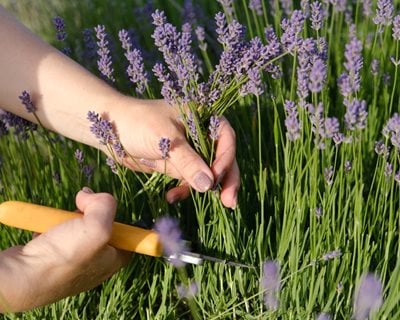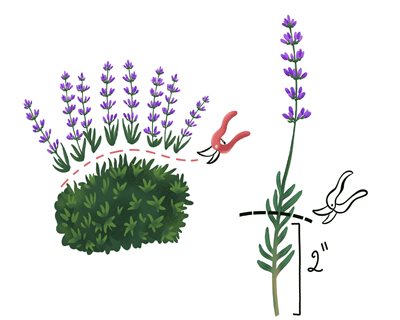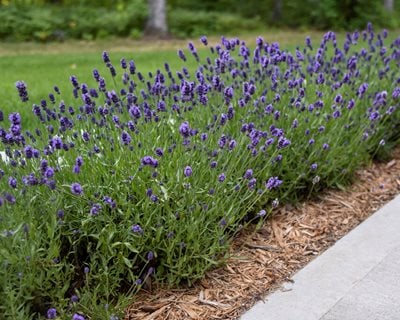A Beginner's Guide to Pruning Lavender
Learn how and when to prune lavender for healthier, fuller plants.
Photo by Renko Aleks / Shutterstock.com
Lavender is not only prized for its long-lasting, fragrant flowers but also for its ability to thrive with very little maintenance. But one chore that’s essential to keeping your lavender shrubs robust, healthy, and attractive is regular pruning.
Although pruning lavender is a fairly easy task that any gardener can master, it’s important to know the proper techniques and timing so you don’t do more harm to your plants than good. By following these basic guidelines, you will minimize stress to your plants while encouraging them to put on a prolific display of flowers year after year.
WHEN TO PRUNE LAVENDER
By cutting back your lavender at least once a year, you will stimulate the growth of lush new foliage and flowers and help to maintain your plant’s shape and fullness. However, some lavender shrubs will benefit from multiple prunings throughout the growing season, depending on their age and vigor. Here’s a breakdown of the optimal timing for your pruning sessions.
- Early spring: You can do an initial pruning in early spring, if necessary, to refine the shape of your plants and remove any winter-damaged stems. Be sure to wait for new leaves to sprout so you avoid cutting into old wood, but prune before the buds appear so you don’t remove the first flush of blooms.
- Late spring: If your lavender grows with a big flush in late spring, prune it immediately after that to encourage a second flush in summer.
- Mid-to-late summer: Prune your lavender shrubs again after the flowers have faded in mid-to-late summer. This is the most important time of year to prune your plants because it will neaten their appearance and control any lanky growth. Because some lavender plants bloom earlier in the season than others, the exact timing of this summer pruning can vary depending on the type of lavender you’re growing.
- Fall: While it’s not necessary to prune your lavender again in the fall, a light trim after the last flush of flowers has faded (but not within 6 weeks of your first frost date) can be beneficial to remove any sprawling branches that could break off or collapse under the weight of ice and snow. This is especially true for English lavender, one of the few lavenders cold-hardy enough to be overwintered outdoors in northern climates.

Illustration by Olga Akbarova
HOW TO PRUNE LAVENDER: 3 STEPS
- Identify where to make your cuts.
Before grabbing your pruning tools, take a close look at your plants and identify where the woody base ends and new foliage growth begins. Always make your pruning cuts above new leaf growth rather than cutting into the woody sections of the plant, since lavender will not form new growth on old wood. The exception is dead or damaged stems, which should be removed right down to the base. - Prune back by about one-third.
Using a sharp pair of hand pruners or hedge shears, cut plants back by at least one-third the length of each stem to remove leggy growth, cutting approximately 2" above the woody part of the stems. When using pruners, you can remove the stems individually or a handful at a time. For larger lavender shrubs, hedge shears are often more practical because they allow you to shape your plants faster. - Shape as you go.
As you work, shape your plant into the desired silhouette, aiming for a symmetrical dome-shaped mound while keeping the look natural. Just be aware that it may take several pruning sessions to achieve the final shape you want. But once you do, you will only have to prune back the uneven growth from your shrub to tidy it up.
TOP LAVENDER PRUNING MISTAKES TO AVOID
- Never cut into the woody part of the plant, unless you are removing damaged stems. If you cut into old wood, there’s a chance your plant won’t regrow.
- Don’t use unsanitized pruning tools. This rule-of-thumb applies when pruning any perennial or shrub, since unsanitized tools can spread diseases from one plant to another. Learn more about how to clean and sanitize your pruning tools.
- If you are growing different types of lavender, don’t prune them all at the same time. Some varieties, such as Spanish lavender, begin to bloom as early as late spring while others delay the show until midsummer. Wait until the first flush of blooms fade before pruning.
- Don’t prune lavender in late fall, or any later than at least 6 weeks before your first frost date, which can make your plants more vulnerable to damage from cold weather. Plants need several weeks to recover from pruning before winter arrives.
WHAT HAPPENS IF YOU DON'T PRUNE YOUR LAVENDER?
Not pruning your lavender can have pretty serious consequences, both in terms of your plant’s appearance and longevity. Because lavender is a semi-woody shrub, it has a tendency to develop elongated, woody stems if plants aren’t pruned regularly. Not only do these scraggly stems produce fewer blooms, they eventually sprawl outward, leaving an ugly hole in the middle of your plant.
What’s more, if you neglect to prune your plants for several years, the woody base will continue to increase in size, making it impossible to restore your plant to its former appearance. Unpruned lavender plants also have shorter lifespans because they are more susceptible to fungal diseases and breakage.

Sweet Romance® Lavender. Photo by Proven Winners
FREQUENTLY ASKED QUESTIONS
Can lavender be cut back to the ground?
Many fledgling lavender growers lose their plants by cutting them completely down to the ground in late fall or early spring, like they do their herbaceous perennials. While you won’t hurt your plant by shearing it back by as much as one-half, you should not cut low into old wood. Always leave behind several inches of green growth.
Can I prune lavender during the growing season?
Light pruning can be done throughout the growing season to promote bushier growth and prolong blooming. You can also prune your lavender while in bloom if you want to harvest the flowers for culinary uses, potpourri, or bouquets.
Should you deadhead lavender?
In addition to pruning, snipping off the blooms of your lavender after they have faded can also be beneficial. Not only will this help keep your plants tidy, it will also encourage more flowers and extend the blooming period.
Can woody lavender be saved?
Once lavender plants become woody and lose their desired shape, restoring them to their bushy appearance can take some time and patience. Start by pruning your plants in the spring, cutting back to the lowest emerging bud. In midsummer, prune again to shape your plants into nice, symmetrical mounds, which will help to reduce straggly growth. Just be sure to wait several months between prunings so your plants have a chance to recover. If your rehabbing efforts aren’t successful, your plants may be too far gone and will need to be replaced.
Should I prune lavender the first year after planting?
Even a first-year lavender plant can benefit from pruning, but you won’t need to cut it back as dramatically as you would a more mature, overgrown plant. By giving your lavender a light pruning the first year after planting, you can shape the plant more easily, encourage bushier growth, and reduce the formation of woody stems.
RELATED:
Growing Lavender
How to Prune Roses
How to Prune Hydrangeas



